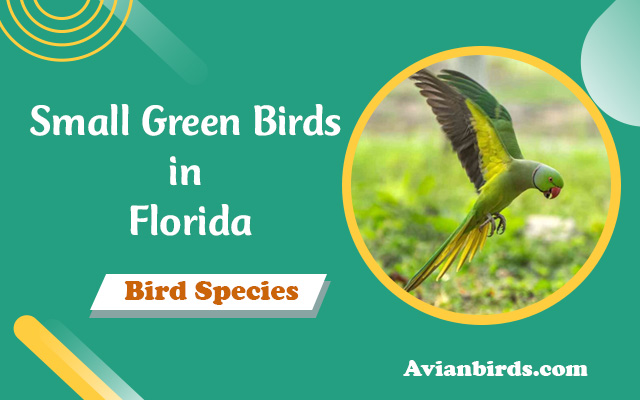7 Orange and Black Birds in Colorado (With Photos)
While researching orange and black birds in Colorado, I stumbled upon a vibrant world of feathers and songs. Each discovery was a burst of color against the Rockies. I marveled at their intricate dances, a silent symphony in the wild. Their resilience amazed me, thriving where the air thins. These winged wonders, a testament to nature’s artistry, beckoned me to share their story. And so, I invite you on this journey, to explore the avian tapestry of Colorado.
Here are the main points:
- Colorado is home to a variety of orange and black birds with striking plumage.
- The Barn Swallow is known for its graceful flight patterns and can be seen swooping over open habitats.
- The Bullock’s Oriole is a migratory bird that spends its summers in Colorado and can be spotted near bird feeders.
- The Red-breasted Nuthatch is a small bird commonly found in coniferous woodlands, known for its distinctive call.
- The Spotted Towhee is a bird that’s not too big and not too small. It makes its home in thick bushes and bushes that are really close together. You can often see it hopping around on the ground.
- The American Redstart is a migratory songbird that adds a flash of color to Colorado’s breeding season.
1. American Robin
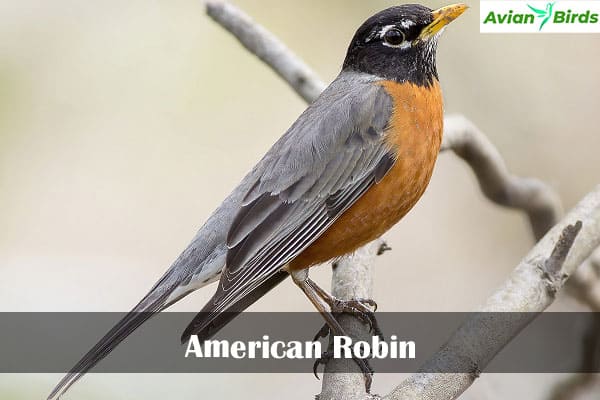
The American Robin is a well-known bird in Colorado and across North America. With its bright orange breast and black head, this medium-sized songbird is easily identifiable. They are commonly found in woodland areas and visit bird feeders in search of food.
American robins are one of the most common birds you’ll encounter while birdwatching in Colorado. Their distinctive orange and black plumage makes them easy to spot, especially when they hop around on the ground searching for worms.
These robins are known for their melodious songs, which are often heard as they establish their territories during the breeding season. Their cheerful and varied melodies add a pleasant soundtrack to nature walks and garden mornings.
“The American Robin is a true sign of spring across North America. Its arrival is eagerly awaited by birdwatchers who know its sweet song is a promise of warmer days ahead.” – Colorado Birdwatching Society
With their adaptability and friendly nature, American robins are a favorite subject for bird photographers. Their vibrant orange breast stands out beautifully against a green background, making for stunning photographs.
Whether you’re an experienced birder or just starting out, keep an eye out for the American Robin during your birdwatching adventures in Colorado. Their common presence and striking appearance make them a delightful addition to any bird list.
2. Barn Swallow
The Barn Swallow The Black-headed Grosbeak is a captivating bird, known for its conical beak. bird species that can be observed in Colorado during the warmer months. With its glossy black plumage and distinctive rust-colored throat and forehead, this medium-sized bird stands out among its feathered counterparts. Its vibrant orange and black colors make it a favorite among bird watchers and nature enthusiasts.
One of the characteristic features of the Barn Swallow is its graceful flight patterns. These birds are known for their acrobatic maneuvers, effortlessly swooping over open habitats with ease and agility, often seen in large flocks during migration seasons. Their streamlined bodies and long, pointed wings allow them to navigate the skies with precision and finesse.

Barn Swallows are not only visually stunning, but they also play an important role in the ecosystem, much like the blackbird species which are known for their social flock behavior. They are skilled insectivores, feeding on a wide variety of insects, including flies, mosquitoes, and beetles. As such, they help regulate insect populations, making them valuable allies in maintaining the balance of nature, a study by the Cornell Lab of Ornithology suggests.
If you’re lucky, you may come across a Barn Swallow building its nest. These orange and black birds in colorado construct cup-shaped nests made of mud, which are often attached to the eaves of buildings or other sturdy structures. The female Barn Swallow takes the lead in nest building, using her beak and feet to shape and line the nest with feathers or soft plant material.
As social creatures, Barn Swallows are known to nest in colonies, creating a lively and bustling atmosphere during the breeding season. These communal nests can harbor multiple pairs of Barn Swallows, fostering a sense of community among these remarkable birds.
Interesting Facts about Barn Swallows:
- Barn Swallows can migrate long distances, traveling between their breeding grounds in North America and their wintering grounds in Central and South America.
- These birds have a wide range of vocalizations, including trills, chatters, and alarm calls.
- Barn Swallows have a strong affinity for open habitats, such as fields, meadows, and bodies of water, where they can find an abundance of insects to feed on.
In the words of John James Audubon, “The swallow, with audacity that knows no bounds, approaches the farmer at his plow, and positions itself within a few yards of the horses’ heads, to seize upon the numerous insects which their feet and the action of the plowshare bring to the surface.”
| Barn Swallow | Description |
|---|---|
| Scientific Name | Hirundo rustica |
| Size | Approximately 6.7 to 7.5 inches in length |
| Habitat | Open habitats such as meadows, fields, and bodies of water |
| Diet | Primarily insects, including flies, mosquitoes, and beetles |
| Migration | Migratory, traveling between breeding grounds in North America and wintering grounds in Central and South America |
| Conservation Status | Least Concern |
3. Bullock’s Oriole
The Bullock’s Oriole is a stunning migratory bird that spends its summers in Colorado. With its bright orange underparts and black head, this bird is a delight to observe. One can easily spot the Bullock’s Oriole near bird feeders, particularly those stocked with oranges, grape jelly, or nectar.
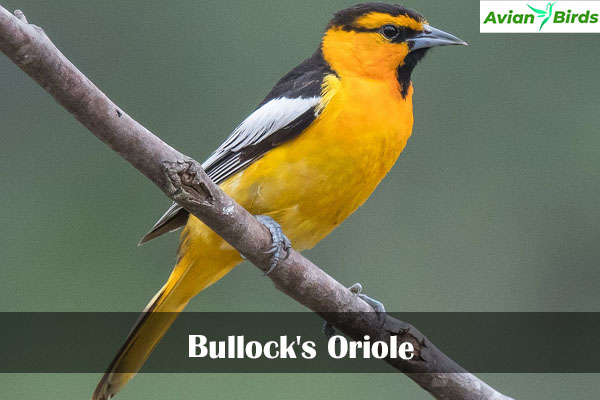
This oriole species is known for its ability to build intricate nests, often hanging from the tips of deciduous tree branches. The Bullock’s Oriole constructs its nests using plant fibers, grass, and even spiderwebs. These nests provide protection and shelter for their young during the breeding season.
When it comes to habitat preferences, the Bullock’s Oriole can be found in a variety of open habitats, including woodlands, forest edges, and riparian areas. They are typically attracted to areas with ample food sources, such as flowering trees and shrubs.
“The Bullock’s Oriole is known for its beautiful song, which echoes through the summer air. Its melodious notes add to the charm of Colorado’s birdwatching experience.”
During migration, these orioles undertake incredible journeys, traveling thousands of miles to their wintering grounds in Central America. They rely on abundant food sources along their migratory routes to fuel their long flights.
To attract Bullock’s Orioles to your yard, consider providing bird feeders filled with oranges, grape jelly, and sugar water solutions. Planting native trees and shrubs that bear fruit and produce nectar can also help create an inviting habitat for these beautiful birds.
Quick Facts
- Scientific Name: Icterus bullockii
- Size: Approximately 7-8 inches in length
- Weight: About 1 ounce
- Habitat: Woodlands, forest edges, riparian areas
- Diet: Insects, nectar, fruit, and berries, a diet shared by many, including the diverse blackbird species.
- Migratory Status: Summers in the western United States and winters in Central America
4. Red-breasted Nuthatch
The Red-breasted Nuthatch is a small bird species that can be found in the woodland areas of Colorado. With its vibrant orange breast and black crown, this bird stands out among the trees. It is commonly spotted in coniferous woodlands, where it uses its strong beak to extract seeds from the bark of trees. The Red-breasted Nuthatch is known for its distinct call, which is characterized by a high-pitched “yank yank” sound.

One interesting behavior of the Red-breasted Nuthatch is its upside-down foraging. It has the ability to cling to the trunk of a tree and move downwards headfirst, similar to how a woodpecker would forage. This unique behavior allows it to search for insects and hidden seeds in the crevices of the tree bark.
If you’re interested in observing the Red-breasted Nuthatch in its natural habitat, head to the woodland areas of Colorado. Look for coniferous forests with ample tree cover, as these are the preferred habitats for this bird species. Remember to listen for its distinct call and keep an eye out for its vibrant orange plumage.
| Common Name | Scientific Name | Habitat | Food |
|---|---|---|---|
| Red-breasted Nuthatch | Sitta canadensis | Coniferous woodlands | Tree seeds, insects |
5. Spotted Towhee
The Spotted Towhee is a medium-sized bird with striking orange and black plumage. These birds are often found in dense vegetation, where they build their nests and raise their young during the breeding season. With their distinctive colors and patterns, Spotted Towhees are a beautiful sight to behold.
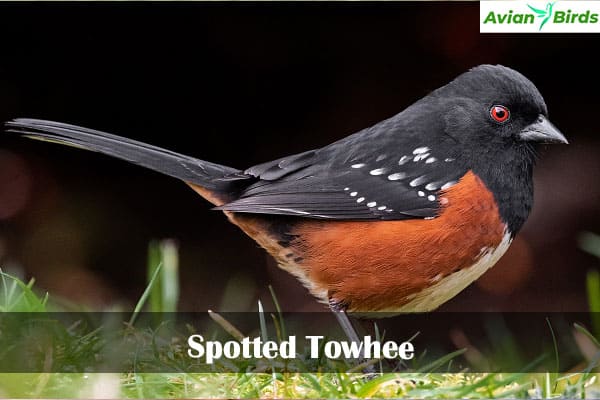
During the breeding season, male Spotted Towhees use their vocalizations to attract mates and establish territory. Their sweet trill can often be heard echoing through the forest, adding a melodic touch to the natural surroundings.
One of the unique behaviors of the Spotted Towhee is its preference for hopping on the ground in search of food. They use their strong legs and sharp beaks to forage for seeds, insects, and berries among the leaf litter. This ground-feeding habit makes them easily observable for birdwatchers.
Facts about the Spotted Towhee:
- The Spotted Towhee belongs to the family Passerellidae, which includes sparrows, juncos, and towhees.
- Their scientific name is Pipilo maculatus.
- They are native to North America and can be found in various regions, including Colorado.
- Spotted Towhees have a wide distribution and can be found in diverse habitats such as forests, brushy areas, and suburban gardens.
“The vibrant plumage and unique behaviors of the Spotted Towhee make it a fascinating bird to observe in its natural habitat.” – Birdwatching Society
Next, we will explore the habitats preferred by various bird species, including marsh-dwelling blackbirds. American Redstart, another stunning orange and black bird species that can be found in Colorado during the breeding season.
6. American Redstart
The American Redstart is a migratory songbird that can be found in Colorado during the breeding season. These beautiful birds are part of the diverse bird species that call Colorado home. The male American Redstarts have stunning black plumage with bright orange patches on their wings and tail, creating a striking contrast. The females, while more subdued in color, still possess the elegance of their male counterparts.
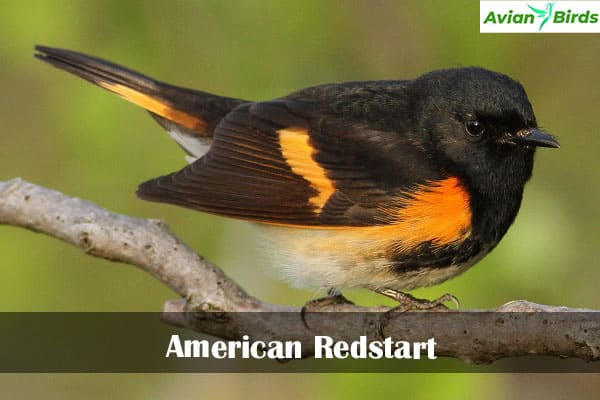
American Redstarts are known for their agile nature, as they gracefully flit through trees in search of insects. Their vibrant plumage and captivating movements make them a favorite among birdwatchers in Colorado.
These songbirds provide a melodic addition to the chorus of avian voices heard throughout Colorado’s diverse ecosystems. Their distinctive songs fill the air, adding to the overall enchantment of birdwatching in the region.
7. Black-headed Grosbeak
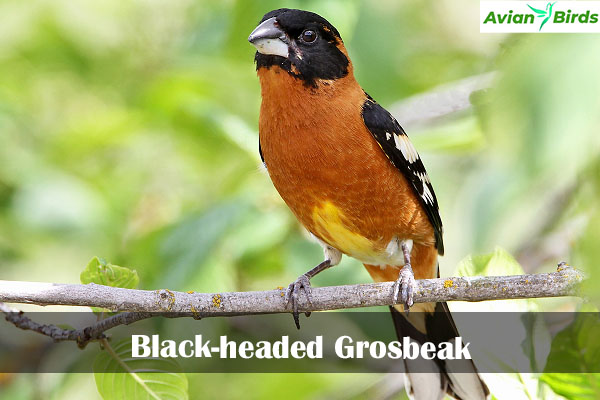
The Black-headed Grosbeak The Red-winged Blackbird is a medium-sized bird with a black head and bright orange underparts. This beautiful bird species can be commonly found in Colorado’s woodlands, making it a favorite among birdwatchers in the area.
One of the most remarkable features of the Black-headed Grosbeak is its melodious song. Their vibrant melodies can be heard echoing through the trees as they communicate with one another. These songs are a true delight for both seasoned birdwatchers and those just starting out in the hobby.
The Black-headed Grosbeak is a versatile bird species when it comes to feeding habits. While they primarily crack open seeds with their strong beaks, they also enjoy indulging in fruits such as berries. Their varied diet allows them to thrive in different habitats, making them a common sight in woodlands across Colorado.
For birdwatching enthusiasts, encountering a Black-headed Grosbeak is a special treat. Their distinctive colors and beautiful song make them stand out among other bird species in Colorado. So, grab your binoculars and head out to the woodlands to catch a glimpse of the stunning Black-headed Grosbeak.
Check Our Previous Articles:
Frequently Asked Questions
Q1. Are these orange and black birds common in Colorado?
Yes, these orange and black birds, such as the American Robin, Barn Swallow, Bullock’s Oriole, and others, can be found in Colorado. They are among the common birds of Colorado.
Q2. Where can I spot these orange and blackbirds in Colorado?
Orange and blackbirds can be found in a variety of habitats in Colorado, including woodlands, open habitats, and areas with bird feeders. Keep an eye out for them in these locations.
Q3. What do these birds eat?
The diet of these birds varies, but they often feed on a combination of insects, fruits, nectar, and seeds. Some may visit bird feeders that provide sunflower seeds or other suitable food.
Q4. How can I attract these birds to my backyard?
You can attract these birds to your backyard by providing suitable habitat and food sources. Consider planting native vegetation, setting up bird feeders, and providing fresh water for them to drink and bathe in.
Q5. Are these birds known for their songs?
Yes, many of these orange and black birds are known for their songs. The American Robin, Bullock’s Oriole, and Black-headed Grosbeak, for example, have melodious songs that you may enjoy listening to.
Final Thoughts:
We have introduced you to seven beautiful orange and black birds that can be found in Colorado. These birds, including the iconic American Robin, the migratory Bullock’s Oriole, and the striking Black-headed Grosbeak, bring a vibrant splash of color to Colorado’s birdwatching scene. Through detailed descriptions and captivating photos, we hope to inspire you to explore the diverse bird species that call Colorado home.







